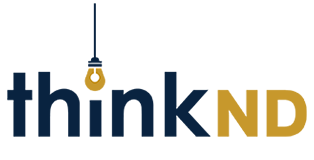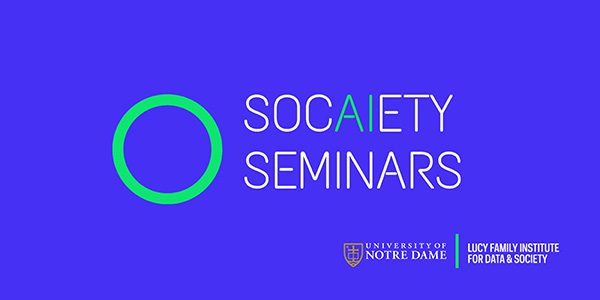Neuroscience and (Your) Behavior – Using neuroscience to build a healthy community
Subscribe to the ThinkND podcast on Apple, Spotify, or Google.
Featured Speakers:
- Nancy Michael, Associate Teaching Professor and Director of Undergraduate Studies for Neuroscience and Behavior, Science University of Notre Dame
- Martin Teicher, Director of the Developmental Biopsychiatry Research Program, Harvard/McLean Hospital
- Kristin Valentino, Director, William J. Shaw Center for Children and Families & William J. Shaw Center for Children and Families Professor of Psychology, A&L University of Notre Dame
The third virtual event of the Neuroscience and (your) Behavior series featured a discussion on how adverse childhood experiences affect the structure and function of the brain and how community treatment movements can mitigate these effects. The event was led by Nancy Michael, Neuroscience and Behavior Associate Teaching Professor and Director of Undergraduate Studies, with special guests Martin Teicher, Director of the Developmental Biopsychiatry Research Program at Harvard/McLean Hospital, and Kimberly Green Reeves, Director of the Beacon Community Impact Team. The speakers shared how their patient-focused research and outreach helps the healthcare community better understand and treat the impacts of childhood trauma.
First, Teicher explained his pioneering discoveries in the field of childhood adversity and brain development. As a physician-scientist in the 1980s, he realized that stress altered not only individuals’ mental states but also the physical structure of their brains. Specifically, his research showed that various types of abuse changed different aspects of the brain’s biology. Teicher highlighted how these adaptations can help children shelter themselves from adverse experiences in their childhood, but they lead to long-term health consequences later on. His new model for brain function merged biological and psychoanalytic approaches to neuroscience. Michael emphasized that this trailblazing research not only led to a more holistic understanding of brain development but also illuminated better ways to treat the effects of adverse childhood experiences.
Next, Kimberly Green Reeves demonstrated how her work with Beacon Health System puts Teicher’s findings into practice, turning his clinical research into a movement for trauma informed care. Reeves shared that in 2012, Beacon completed their first Community Health Needs Assessment, which allowed them to monitor data on patient wellbeing and shift their practices accordingly. However, Reeves stressed that Beacon must see itself as a collaborator in the process to mitigate the neurobiological effects of adverse childhood experiences, learning from those who have suffered traumas as well as helping them heal. Beacon has launched a number of programs to support families experiencing trauma as well as prevent adverse childhood experiences from occurring in the first place. Teicher added that such measures are the best way to treat the physical and mental consequences of stress in communities over the long term.
During their discussion, Teicher, Reeves, and Michael illustrated the link between research and treatment in the field of neuroscience, as patient data can help scientists, physicians, and healthcare workers better avert and alleviate the effects of childhood trauma. This use of neuroscience does not only increase knowledge of the human brain, but it also leads to positive, intergenerational change in people’s lives.
While it might sound strange at first, a child’s developing brain has certain expectations from its environment. Consistent and responsive care are important for a healthy child and later a healthy adult. Through responsive, consistent care, older humans become powerful protective factors to buffer the stresses of daily life for our younger citizens. The fields of neuroscience, epigenetics, adversity, and resilience teach us that “stress-dose” during early development can have tremendous impact on brain development, behavior and even life-long health. Delve into how brain development is bedrock to healthy communities. What can we all do differently to improve our overall health and the health of our communities and protect our most vulnerable?
While it might sound strange at first, a child’s developing brain has certain expectations from its environment. Consistent and responsive care are important for a healthy child and later a healthy adult. Through responsive, consistent care, older humans become powerful protective factors to buffer the stresses of daily life for our younger citizens. The fields of neuroscience, epigenetics, adversity, and resilience teach us that “stress-dose” during early development can have tremendous impact on brain development, behavior and even life-long health. Delve into how brain development is bedrock to healthy communities. What can we all do differently to improve our overall health and the health of our communities and protect our most vulnerable?
- A data-driven approach can help healthcare providers address the effects of trauma in their communities (7:15)
- A person’s age and the type of adverse experience they undergo will affect how the structure and function of their brain changes in response. (21:06)
- Abuse can alter a person’s conscious perception of a threat but leave the structures that regulate unconscious perception intact (24:35)
- Trauma-informed care teaches people in the healthcare system and beyond how to be trauma aware, trauma sensitive, trauma responsive, and trauma informed (41:45)
- “Together I think that [the guests] can offer a remarkably complementary view of how issues of unbuffered stress dose…and childhood adversity can impact not only neurobiology and behavior but also broader community health” (Nancy Michael, 4:28)
- “The dawning realization was that childhood adversity led to these alterations in their brains and their symptoms…Back in 1984 that was a very radical thought” (Martin Teicher, 15:11)
- “I was sort of changing the model and saying these experiences aren’t just encoded in our ‘software;’’ these are actually structurally, physically changing our brains. And so you…begin to have an intersectionality between the experiences and the functioning of the brain” (Martin Teicher, 16:11)
- “Easily within most of our guests’ lifetimes…the field of medicine really has gone through a really dynamic, life-changing shift in perspective in terms of social [and] cultural change…When we want to address these issues in a community setting, it’s not only about the evidence…but then how that evidence is disseminated [and] communicated” (Nancy Michael, 19:01)
- “So basically, we were finding that specific types of abuse were modifying the sensory systems that conveyed that information and probably altering how much [patients] perceived this, at least consciously, in a way to help them make it through their childhood” (Martin Teicher, 23:21)
- “Our theory of change is to make someone aware. So we’re going to make someone aware that [adverse childhood experiences] exist but that…the impacts of trauma can be mitigated” (Kimberly Green Reeves, 31:11)
- “While we have a professional lens through our training, [community stakeholders] also have a lens of expertise through their experience and their environment that they can bring to the table” (Kimberly Green Reeves, 33:30)
- “This has to be a collaborative movement that we are creating as a community in order to make sure that we can heal together.. I want to stress that it’s going to take time, but we have to start somewhere” (Kimberly Green Reeves, 43:53)
- “Burying [trauma] doesn’t actually solve the problem; it just makes it worse for ourselves, and then we have a higher likelihood of passing it on to our children and within our community” (Nancy Michael, 49:12)
- “We always talk about kids as if they’re our future, but they’re here now, their neurobiologies are here now, and we have to take care of them now” (Nancy Michael, 53:53)
Related Content
Reunion 2024
Alumni Education Programming Click each program title to learn more. ND Perspectives: Election 2024 and the Future of Democracy in the U.S. The 2024 presidential election looms...
Read ArticleA Brave New World of AI Governance
Explore the connection between data, geopolitics and governance, regulation, self-regulation while discovering examples of good and bad practices in various sectors, such as...
View EventAlgorethics: potentiality and challenges in the age of AI
Explore the possibilities and challenges in ethical governance of AI through algorethics. Algorethics is a term that has been developed since 2018 to denote the need for a study...
View Event

